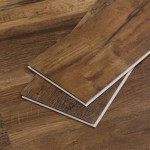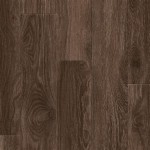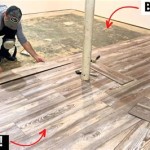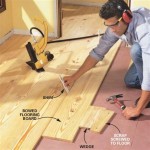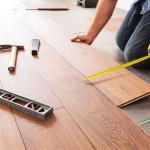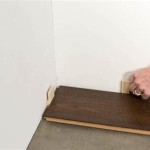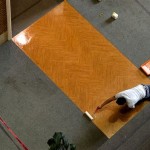Vinyl Flooring: A Practical Choice for Kitchens
Vinyl flooring has emerged as a popular and versatile option for kitchens, offering a compelling blend of durability, aesthetics, and affordability. It presents a significant alternative to traditional kitchen flooring materials like tile, hardwood, and laminate. Understanding the properties and benefits of vinyl flooring is crucial for homeowners seeking to make informed decisions about their kitchen renovation or construction projects.
Vinyl flooring is a resilient flooring material constructed from multiple layers. These layers typically include a backing layer, a core layer, a printed design layer, and a protective wear layer. The backing layer provides stability and cushioning. The core layer, often made of fiberglass or vinyl composite, contributes to the flooring's dimensional stability and resistance to moisture. The design layer is a printed image that replicates the appearance of wood, stone, tile, or other desired patterns. The wear layer is a transparent, protective coating that safeguards the design layer from scratches, stains, and wear.
Vinyl flooring is available in several formats, each with its own installation method and characteristics. Sheet vinyl is a large, continuous roll of flooring that is adhered to the subfloor. Vinyl tiles are individual squares of vinyl that are also typically glued down. Plank vinyl replicates the look of hardwood flooring and is available in glue-down, click-lock, and loose-lay options. Understanding these different formats is important when considering the specific requirements and preferences for a kitchen flooring project.
Water Resistance and Durability
One of the most significant advantages of vinyl flooring for kitchens is its inherent water resistance. Unlike hardwood or laminate, vinyl is largely impervious to water damage. This makes it an ideal choice for kitchens, where spills, splashes, and moisture are common occurrences. The waterproof nature of vinyl flooring helps to prevent mold and mildew growth, contributing to a healthier and more hygienic kitchen environment. This resistance extends beyond surface spills; some types of vinyl flooring, particularly those with waterproof cores, can withstand prolonged exposure to moisture without warping or degrading.
The durability of vinyl flooring is another key benefit. The wear layer, which protects the surface from everyday wear and tear, plays a crucial role in the flooring's longevity. The thickness of the wear layer directly correlates to the flooring's resistance to scratches, dents, and scuffs. For high-traffic kitchens, a thicker wear layer is recommended to ensure the flooring maintains its appearance over time. Vinyl flooring is also resistant to staining, making it easy to clean and maintain. Routine sweeping and mopping are typically sufficient to keep vinyl floors looking their best.
Furthermore, vinyl flooring is often more forgiving than harder surfaces like tile or stone. It offers a degree of cushioning underfoot, making it more comfortable to stand on for extended periods. This can be especially beneficial in kitchens, where individuals often spend a significant amount of time preparing meals or performing other tasks.
Aesthetic Versatility and Design Options
Vinyl flooring offers an extensive range of design options, allowing homeowners to achieve virtually any desired aesthetic in their kitchens. The printed design layer can replicate the appearance of natural materials like wood, stone, and tile with remarkable accuracy. Modern printing technology allows for highly realistic textures and patterns, creating visually appealing and convincing reproductions.
For those seeking the look of hardwood, vinyl plank flooring offers a cost-effective and low-maintenance alternative. Vinyl planks can mimic various wood species, grains, and finishes, providing the warmth and elegance of hardwood without the associated susceptibility to moisture damage. Similarly, vinyl tiles can replicate the look of stone or ceramic tile, offering a wide array of colors, sizes, and patterns. This versatility allows homeowners to create a custom look that complements their kitchen's style and décor.
In addition to replicating natural materials, vinyl flooring is also available in a wide range of solid colors, patterns, and textures. This opens up possibilities for creating bold and unique designs, adding personality and visual interest to the kitchen. The ability to customize the design allows homeowners to create a space that reflects their individual tastes and preferences.
The format of vinyl flooring also contributes to its aesthetic versatility. Sheet vinyl offers a seamless appearance, minimizing grout lines and creating a clean, uniform look. Vinyl tiles and planks allow for more intricate patterns and designs, providing flexibility in layout and customization. The choice of format depends on the desired aesthetic and the specific requirements of the kitchen space.
Cost-Effectiveness and Ease of Installation
Vinyl flooring is generally more cost-effective than many other kitchen flooring options, such as hardwood, tile, and stone. The lower material cost and reduced installation expenses make it an attractive choice for homeowners on a budget. While the exact cost of vinyl flooring varies depending on the quality, thickness, and format, it typically represents a significant savings compared to more premium materials.
The installation process for vinyl flooring can be relatively straightforward, particularly for click-lock and loose-lay options. These types of vinyl flooring do not require adhesive and can be installed by homeowners with basic DIY skills. Glue-down vinyl, on the other hand, requires more precision and experience, and may benefit from professional installation. Sheet vinyl installation is generally best left to professionals due to the size and complexity of the material.
The ease of installation can further reduce the overall cost of a kitchen flooring project. By opting for a DIY-friendly installation method, homeowners can save on labor costs and complete the project at their own pace. However, it's important to carefully follow the manufacturer's instructions and prepare the subfloor properly to ensure a successful and long-lasting installation.
The lower maintenance requirements of vinyl flooring also contribute to its long-term cost-effectiveness. Unlike materials that require specialized cleaning products or periodic refinishing, vinyl flooring is easy to clean and maintain with simple household cleaners. This reduces the ongoing expenses associated with maintaining the flooring's appearance and performance.
When considering the overall cost of kitchen flooring, it's important to factor in not only the initial purchase price but also the installation costs, maintenance requirements, and potential for repairs or replacements. Vinyl flooring offers a compelling combination of affordability, durability, and ease of maintenance, making it a cost-effective choice for many homeowners.
The subfloor preparation is crucial for any type of vinyl flooring installation. The subfloor must be clean, level, and dry. Any imperfections or unevenness in the subfloor can telegraph through the vinyl flooring, affecting its appearance and performance. Cracks or holes should be filled with a patching compound, and any loose debris should be removed. In some cases, a self-leveling compound may be necessary to create a perfectly smooth surface.
Choosing the right type of vinyl flooring for a kitchen depends on several factors, including the budget, the desired aesthetic, the level of traffic, and the potential for moisture exposure. Luxury vinyl plank (LVP) and luxury vinyl tile (LVT) are popular choices for kitchens due to their durability, realistic appearance, and water resistance. These types of vinyl flooring typically have a thicker wear layer and a more robust core, making them suitable for high-traffic areas.
Proper maintenance is essential for extending the lifespan of vinyl flooring. Regular sweeping or vacuuming helps to remove dirt and debris that can scratch the surface. Mopping with a mild detergent and water is sufficient for most cleaning needs. Harsh chemicals, abrasive cleaners, and excessive water should be avoided, as they can damage the wear layer. Placing mats at entrances and under sinks can help to protect the flooring from dirt and spills.
While vinyl flooring is generally durable and resistant to damage, it is not indestructible. Sharp objects can scratch the surface, and heavy objects can dent or puncture the flooring. When moving furniture or appliances, it's important to use protective pads or dollies to prevent damage. Promptly cleaning up spills can help to prevent stains. By taking these precautions, homeowners can keep their vinyl flooring looking its best for years to come.
The evolution of vinyl flooring technology has led to significant improvements in its performance and appearance. Modern vinyl flooring offers enhanced durability, realistic designs, and easier installation methods. These advancements have made vinyl flooring an increasingly popular choice for kitchens and other areas of the home.
The availability of green and sustainable vinyl flooring options is also growing. These products are made from recycled materials and are designed to minimize their environmental impact. Choosing a sustainable vinyl flooring option can contribute to a healthier and more eco-friendly kitchen.
Choosing Vinyl Flooring For Your Kitchen Tarkett

How To Choose Best Vinyl Flooring For Kitchen Scv Floorsmith

Vinyl Flooring In The Kitchen

Why Vinyl Flooring Is The Perfect Choice For Your Kitchen

Is Vinyl Flooring The Best Choice For Kitchens

6 Vinyl Flooring Myths Get The Facts From Our Experts Inc

Manor House Bitterne Stone Tile 4mm Cushioned Sheet Vinyl Flooring

Kitchen Vinyl Flooring Lino Free Samples Factory Direct

Luxury Vinyl Tile How It S Made Its Design Possibilities

Coreluxe 5mm W Pad Daydream Meadow Oak Waterproof Rigid Vinyl Plank Flooring 6 In Wide X 48 Long Ll
Related Posts

